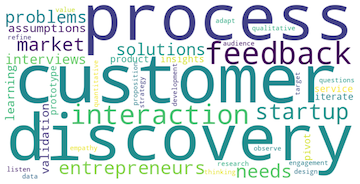Startup Mondays: A Customer Discovery Guide
Department(s):
The Business School 
At the core of every successful startup is a deep understanding of its customers. The customer discovery phase is not just an initial step but a foundational element that can determine the trajectory of a startup. It's about stepping out of the building, metaphorically and sometimes literally, to engage with potential customers and learn directly from them. This article delves into the essentials of customer discovery, offering a roadmap for startups to navigate this enlightening process.
Understanding Customer Discovery: Customer discovery is the process through which startups validate the existence of a problem worth solving and identify who experiences this problem most acutely. It’s an exploratory phase that requires an open mind and the willingness to be proven wrong, to ensure that you’re building a product or service that addresses real needs.

Steps for Effective Customer Discovery:
- Formulate Your Hypotheses: Begin with clear hypotheses about who your customers are, the problems they face, and how your product or service can solve these issues. These are assumptions that will guide your discovery process.
- Develop Your Interview Strategy: Create a plan for reaching out to potential customers. This includes deciding on the methods (e.g., in-person interviews, surveys, focus groups) and drafting a set of open-ended questions that encourage detailed responses.
- Conduct Customer Interviews: Engage with potential customers through interviews, striving to understand their needs, behaviors, and the context of their problems. The goal here is to listen more than you speak, allowing their insights to guide the conversation.
- Iterate and Refine: Use the insights gathered from these interviews to refine your hypotheses. This may lead to adjustments in your understanding of the customer, the problem, or even the solution you’re proposing.
- Identify Patterns and Validate Problems: As you speak with more potential customers, look for patterns in the feedback. These trends are crucial for validating the problems you aim to solve and understanding the commonalities among your target customers.
Best Practices for Customer Discovery:
- Embrace the Learning Mindset: Approach customer discovery as a learning process, where being proven wrong is as valuable as being validated. It’s about gathering insights to guide your startup in the right direction.
- Be Open and Curious: Avoid leading questions that confirm your biases. Instead, foster open-ended conversations that allow customers to express their genuine thoughts and experiences.
- Diversify Your Sources: Speak with a wide range of potential customers to ensure a broad understanding of the problem space. This diversity can reveal different dimensions of the problem you’re solving.
- Document Everything: Keep detailed notes from each interview and meeting. These records are invaluable for identifying patterns and informing future decisions.
Customer discovery is an ongoing process that doesn’t end after the initial launch of a product or service. It’s a mindset that values continuous learning and adaptation based on customer feedback. By rigorously engaging in customer discovery, startups can avoid the costly mistake of building something nobody wants, instead creating solutions that genuinely meet customer needs and drive success.